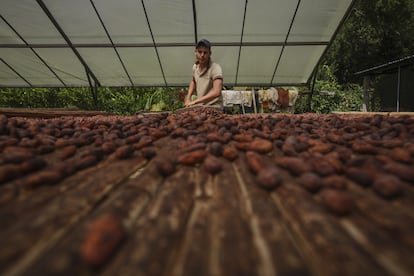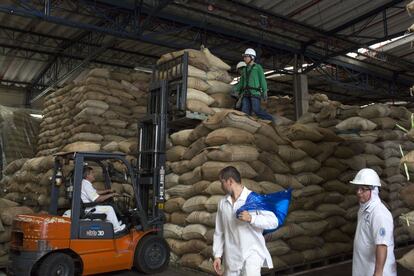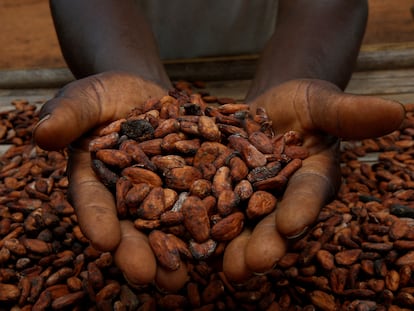Cocoa price surge in global market lures Colombian farmers away from coca cultivation
The climate crisis’ impacts on major African producers has seen cocoa prices soar by over 150%

“Coca leaf prices are down and cocoa prices are up.” It’s as simple as that, says cocoa farmer Óscar Gómez, who close to the Sierra Nevada de Santa Marta, an isolated mountain range near Colombia’s Caribbean coast. The story begins thousands of miles north at the New York Mercantile Exchange, the commodities market where the price of cocoa recently hit a record high of $10,000 per ton. This marks a significant increase of over 150% since January 2023. With supply problems and poor harvests in the Ivory Coast and Ghana, which account for 60% of the world’s cocoa, major buyers are looking to countries like Colombia. Despite historically lower production levels of around 60,000 tons annually, Colombia may be poised to become a bigger player in global markets.
It’s an evolving story with many Colombian farmers used to low prices starting to pay attention. International shifts due to a huge supply-demand gap and rising prices have caught many by surprise. Current estimates show a global cocoa deficit of 300,000-500,000 tons. Analysts predict prices won’t drop significantly in the near future.

According to Gustavo Pradilla, owner of the small Tibitó chocolate brand, international buyers have been coming to local markets for months to supply their operations in Europe. “They basically just buy cocoa at the offer price – no haggling.” And the surge in the commodities market has finally trickled down throughout the supply chain. “It’s a bonanza for farmers!” said Óscar Gómez. “Plus, it’s a great opportunity to reinvest resources into adapting our crops to organic fertilizers.”
The goal is to spark excitement and prevent young people from leaving rural areas for cities. This issue is particularly challenging in other agricultural sectors like coffee cultivation. The cocoa industry is crucial for regions wracked by decades of violence, where the Colombian government is implementing initiatives to help farmers and farmworkers transition from illegal coca plantations to cocoa.
That’s why the peace deal between the government and the former FARC guerrilla in 2016 hinges on the outcome of such projects. “Government policies seem to be producing results in some areas,” said cocoa farmer Pablo Emilio Ome, who lives in Caquetá (southern Colombia).
Ome, who said he is wary of interviews due to recent threatening calls from criminal groups, noted that many coca growers in his area are shifting to cocoa. “People are ditching the alkaloid crops [poppies, coca]. And what’s more, no one’s buying because gas and supplies got way more expensive. So, you’ve got a bunch of folks feeling pretty discouraged by those crops and taking a close look at government programs for crop substitution.”
Oberman Torres, who heads the Bajo Mira y Frontera community council in Tumaco (southwestern corner of Colombia), said, “Our council has around 900 families producing cocoa. The goal is for all of them to grow certified organic cocoa.” He mentions that recent market conditions have accelerated the shift from illegal coca to the cocoa industry in his area. “In Tumaco, a kilo now costs 26,000 pesos [$6.80], up from 10,000-11,000 pesos [$2.60-$2.88] at the start of 2023. So, small producers are definitely seeing the impact of the international price hike.”

But Torres says that cocoa isn’t a profitable business yet. Due to post-pandemic inflation, production costs have increased. The benefits of the global cocoa price surge have not yet been felt by local farmers. “To achieve balance, I estimate the price per kilo should be about 16,000 pesos [$4.20]. Although the situation is encouraging, producers must still overcome several challenges for sustainable success.”
Major commercial brands like traditional Luker chocolate (part of the Nutresa group), along with artisanal brands like Tibitó and Moxẽ, have raised product prices between 16% and 30%. Juan Carlos Garavito, co-founder of Moxẽ, says global consumers should expect to pay slightly higher prices for chocolate bars in the coming years. “We need to educate consumers on why they may be paying more, and make efforts to ensure fair prices along the supply chain, especially for the farmers.”
Several experts foresee the impacts of climate change and pests on African crops lasting no more than two years. Óscar Gómez acknowledges that Colombian cocoa farmers were taken by surprise at the change in market conditions, and says they struggle to boost productivity and improve crop management. “We’ve got plenty of room to improve productivity and quality. Places like Tumaco, Arauca, Meta and the Sierra Nevada are real gems known for their top-notch 100% cocoa unsweetened chocolate.” Gómez repeats some of the same complaints often heard from coffee farmers. “We need to be more aware of all the things our land can produce.”
According to Juan Carlos Garavito, neighboring countries like Ecuador, Peru and Venezuela have claimed better positions in the global market. He notes Colombia’s slower progress, even though an association in Meta (central Colombia) recently won the best cocoa award in Holland. “Cocoa in Colombia was declared a ‘peace’ crop,” said Paola Forero, co-founder of Moxẽ. “That’s because plantations got smaller over the years in the most violence-prone areas.”
After the 2016 Havana peace accord, international aid efforts have focused on training cocoa producers and providing equipment. Resources have been mobilized to develop cocoa-producing regions. “I believe we’re currently in a phase akin to coffee 30 years ago when we used to drink a low-cost product of average quality,” said Forero, who believes Colombian consumers are now realizing the country produces high-quality cocoa. “Our challenge now is to provide cocoa farmers with better capabilities to capitalize on the boom and brace for commodity market volatility.”
Sign up for our weekly newsletter to get more English-language news coverage from EL PAÍS USA Edition
Tu suscripción se está usando en otro dispositivo
¿Quieres añadir otro usuario a tu suscripción?
Si continúas leyendo en este dispositivo, no se podrá leer en el otro.
FlechaTu suscripción se está usando en otro dispositivo y solo puedes acceder a EL PAÍS desde un dispositivo a la vez.
Si quieres compartir tu cuenta, cambia tu suscripción a la modalidad Premium, así podrás añadir otro usuario. Cada uno accederá con su propia cuenta de email, lo que os permitirá personalizar vuestra experiencia en EL PAÍS.
¿Tienes una suscripción de empresa? Accede aquí para contratar más cuentas.
En el caso de no saber quién está usando tu cuenta, te recomendamos cambiar tu contraseña aquí.
Si decides continuar compartiendo tu cuenta, este mensaje se mostrará en tu dispositivo y en el de la otra persona que está usando tu cuenta de forma indefinida, afectando a tu experiencia de lectura. Puedes consultar aquí los términos y condiciones de la suscripción digital.
More information
Archived In
Últimas noticias
Welcome to the post-religion era: The idea of Christianity as the absolute truth has become obsolete
‘I thought you would like it’: The risky sexual practice popularized by TV shows and TikTok
The digitalization of tourism: ‘They promise experiences and gave us the worst possible one’
Mexican peso defies uncertainty with forecasts of a new period of stability in 2026
Most viewed
- Sinaloa Cartel war is taking its toll on Los Chapitos
- Reinhard Genzel, Nobel laureate in physics: ‘One-minute videos will never give you the truth’
- Oona Chaplin: ‘I told James Cameron that I was living in a treehouse and starting a permaculture project with a friend’
- Why the price of coffee has skyrocketed: from Brazilian plantations to specialty coffee houses
- Silver prices are going crazy: This is what’s fueling the rally











































